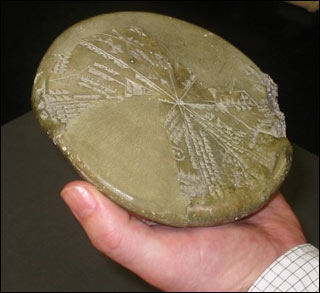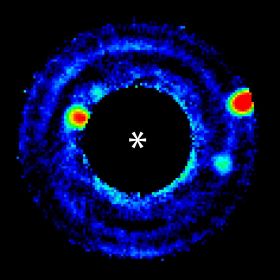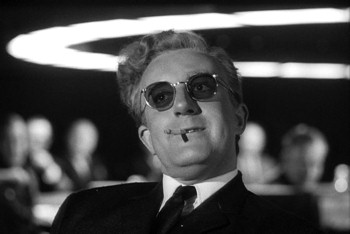The Plan:
Near the end of WWII, things were rapidly going south for Germany and the time seemed ripe for guilt-ridden Nazi officers to assassinate Hitler and overthrow his government. Colonel Henning von Tresckow recruited Colonel Claus von Stauffenberg to join the conspiracy in 1944.The plot to take out Hitler and then all of his loyal officers was called Operation Valkyrie, based on the belief that no plan can fail if it has a cool enough name.
How did that work out?
In July 1944, Stauffenberg was promoted so that he could now start attending military strategy meetings with Hitler himself. On more than one occasion Stauffenberg planned to kill Hitler at such a meeting with a briefcase bomb, but he always held off because he also wanted to take out Hitler’s two right-hand men, Hermann Goering and Heinrich Himmler. On July 20, he went for it anyway and exploded a bomb inside Hitler’s conference room with a remote detonator.Hitler, who as a level-20 dark wizard had extraordinary damage absorption abilities, survived with only minor injuries.Stauffenberg fled when he found out his assassination attempt had failed and that the Fuhrer was explosion-proof. When the other conspirators found out that Hitler was still alive, they lost their nerve and Operation Valkyrie never went into effect. After the coup never got off the ground, several conspirators committed suicide, and Fromm turned in the rest to save his own skin. Unfortunately for him, Hitler wasn’t nearly as forgiving as his fiery public speeches and penchant for genocide would lead you to believe, and Fromm was executed along with the remaining conspirators.The good news for the legacy of Claus von Stauffenberg is that he’s become something of a folk hero in Germany, a symbol of conscientious resistance to the Nazi regime.
#5. Operation Ajax
The Plan:
For years, Britain had a spiffy trade deal with Iran regarding their prodigious oil fields. The Anglo-Iranian Oil Company was basically a giant money machine for the Anglo half, while the Iranian half got shafted. That all changed in 1951 when Iran nationalized the AIOC and the Iranian parliament elected Mohammed Mossadegh as Prime Minister. Mossadegh was relatively secular, something that pissed of Iranian clerics, but he was also very nationalistic. When Britain tried to regain control of the AIOC, he gave them the finger. Tea was spilled, crumpets were dropped and monocles everywhere popped out in shock.
You can guess what happened next. Jolly old England went to its ally, the United States, and convinced President Dwight D. Eisenhower to help overthrow the democratically elected leader of Iran and install a pro-West monarchy. Together the CIA and British intelligence services funneled guerrilla troops, anti-Mossadegh propaganda and tons of bribes into Iran.
How did that work out?
In the short term? Great! The mostly ceremonial position of Shah (king) of Iran was restored to its former imperial glory, but this time as a puppet of the West. The White House and Tehran became BFFs, and as long as the US government overlooked the numerous human rights abuses happening in Iran, all was well.
Until 1979, that is, when a pissed off Iranian populace finally revolted and replaced the monarchy with an anti-West Islamic Republic. One messy hostage crisis later, and Iran and the US were no longer BFFs. But hey, at least the US learned a very important lesson about overthrowing the governments of unfriendly Middle Eastern countries.
The Anglo-Iranian Oil Company is now known as Britsh Petroleum
#4. The Gunpowder Plot
The Plan:
A group of conspirators (including Guy Fawkes, Natalie Portman and Hugo Weaving) decided to blow the fuck out of the British House of Parliament, thus killing pretty much all of the aristocracy, as well as King James I.
In May of 1604, a group of Britons who were fed up with King James’s rule met with Robert Catesby. As Catholics, they were tired of the Protestant government. In accordance with the teachings of their faith, they apparently decided that the best way to solve their problems was to kill everyone.
The conspirators were taking up residence across the street from The House of Lords, the building the upper house of parliament met in. Their original plan was to burrow their way to the underground foundation of The House of Lords, and lay their explosives there. When that proved to be more difficult than they had originally planned, they decided to just rent a room in the cellar of building. The explosives were quickly moved into place, and all that was left was to wait for the annual Opening of Parliament.
How did that work out?
While they were waiting, one of the conspirators sent a letter to Lord Monteagle, a high ranking Catholic, which basically said, “Hypothetically, we could blow up Parliament on the day it opens this year. So don’t go, hypothetically speaking.” This proved to be their undoing, as Lord Monteagle immediately passed the news on to the Secretary of State. The House of Lords was searched, and Guy Fawkes, the man left in charge of watching the explosives, was found and arrested.
None of the protestant politicians were killed, but the plan wasn’t a complete failure. King James admitted in a speech that not all Catholics were as crazy as the ones arrested in connection with the plot, which is good, because a lot of historians have suggested that if the plot succeeded, there would have been a very violent backlash against Catholic communities. Plus, England now celebrates Guy Fawkes night every November 5th.
Apparently the conspirators had also planned to kidnap the royal children, as well as incite a revolt. However, they never made it to this part of their plan due to the fact that they had been hung and eviscerated.
#3. The Tuskegee Experiment
The Plan:
Sometimes referred to as the Tuskegee Syphilis Experiment, the idea was that the United States government was going to monitor the effects of syphilis and perform experiments on those who had a developed form of the disease. That doesn’t sound so bad, right? Well you’re a terrible person for thinking that, because the experiments were exclusively performed without consent, and on the very poor, mostly illiterate black males.
These men weren’t told that they had syphilis and were denied proper treatment for their disease. Because that would have skewed the results, you see. But hey, at least the government promised free burials to those who died.
How did that work out?
The study (started in 1932 in Tuskegee, Alabama) eventually rounded up 400 black men in a move that would inspire Rage Against the Machine-esque lyrics for years to come. But, contrary to conspiracy enthusiasts, they did not actually give people syphilis, they just examined the symptoms of people who already had the disease. Then, things got out of hand:
Doctor 1: “Darn. I’m afraid that we might not get the numbers we want for the next part of this study.”
Doctor 2: “Why is that?”
Doctor 1: “Because it involves administering a painful and dangerous spinal tap for no medical reason.”
Doctor 2: “Hmm … Well, why don’t we just underline the word “Free” and tell them that it’s a special treatment for their symptoms.”
Doctor 1: “But, wouldn’t that be a horrible lie?”
Doctor 2: “A horrible what?”
When there was a national campaign to use penicillin to stamp out the disease, those in the study were denied access. If they complained loudly enough, they were given a placebo and then sent back home to die. But not before scientists poked and prodded them for the remaining years of their life.
It took until 1972 for someone to blow the whistle on all of this. That’s 40 years. And that’s after Peter Buxtun, the whistle blower, went to the Center for Disease Control, which told him that they would absolutely end this barbaric experiment, just as soon as they completed the last stage of the study. That stage involved studying the corpses of the subjects, and of course they couldn’t do that quite yet because some were stubbornly still alive.
As a result, in 1974 they passed the National Research Act, which finally closed the apparent loophole in American law that said it was OK for mad scientists to kill people in their experiments.
#2. Operation Snow White
The Plan:
Some time during the 1970s, the Church of Scientology decided that they’d had enough. Their religion about magic space aliens in a volcano wasn’t getting the same respect as the religion about the magic bearded man whose dad made us all out of mud 6,000 years ago. Instead of converting to a slightly less silly religion, they did what any of us would have done and decided to destroy every single document that made their religion look bad, presumably including a trip into the future to destroy every copy of Battlefield Earth.
How did that work out?
Disturbingly well, at least for a little while. Apparently, the Church of Scientology managed to perform the largest infiltration of the United States government in history. Ever. With all the people who have wanted to get their dirty little hands on incriminating records, the United States of America was finally duped by the people who came up with Dianetics. So those billions of dollars we put into national security annually are clearly well spent.
Anyway, somewhere around 5,000 of Scientology’s crack commandos wiretapped and burglarized various agencies. They stole hundreds of documents, mainly from the IRS. No critic was spared, and in the end, 136 organizations, agencies and foreign embassies were infiltrated.
When all of this hit the fan, the Church naturally denied it. Then they kidnapped one of the operatives arrested for stealing documents and prevented him from testifying. These days, the Church of Scientology generally refuses to talk about Operation Snow White, except to say that they “purged” those who were involved. They won’t say what the guilty parties were involved in, and those who were purged still hold high ranking offices in the Church, but goddamn it, they were purged for their involvement.
#1. Project MKULTRA
The Plan:
Don’t be fooled. Project MKULTRA isn’t the misspelled secret recipe to McDonald’s newest hamburger. It was actually a series of CIA experiments in which they tried to figure out how to control your mind. Over a hundred sub-projects were authorized under the MKULTRA heading, though the documents on many of those have been destroyed.
How did that work out?
If you listen to late night talk radio, then you’ve probably already heard of Project MKULTRA. Paranoid schizophrenics from coast to coast like to call in to recount their harrowing tales of psychic violation at the hands of the CIA. Turns out the schizophrenics got something right though, because Project MKULTRA was an actual series of experiments started on April 13, 1953.
You can decide for yourself whether or not the late-night radio callers are actually victims of these experiments, though we would like to suggest that if they are all telling the truth, it’s strange that the CIA would only experiment on nocturnal conspiracy-nuts.
The project started out as a response to rumors of Communist mind control being used on American prisoners from the Korean War. Afraid of being left in the enemy’s pseudo-scientific dust, the CIA quickly jumped on the mind control bandwagon. However, they got their procedures wrong in one crucial aspect; instead of experimenting on enemy prisoners that the national media wouldn’t miss, they decided to go ahead and start jamming probes and shooting drugs into unwitting United States citizens.
Did we mention that these experiments resulted in at least one death? Or that experiments done on people seeking treatment for minor psychological issues (such as anxiety) often caused them to suffer permanent comas and/or incontinence? Or that the CIA themselves admitted that the experiments made no scientific sense?
The project was eventually found out, and the CIA was given a stern talking to.
As far as anyone can tell, they were unable to succeed in finding a way to control the way people act or think. Though we’d probably say the same thing if they had succeeded.







